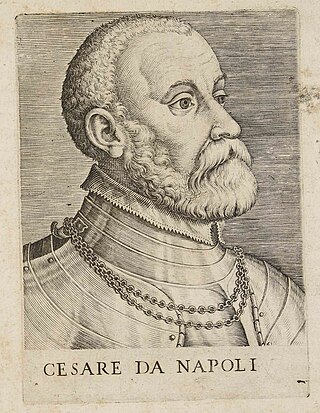Related Research Articles

Roger Borsa was the Norman Duke of Apulia and Calabria and effective ruler of southern Italy from 1085 until his death.

Guaimar IV was Prince of Salerno (1027–1052), Duke of Amalfi (1039–1052), Duke of Gaeta (1040–1041), and Prince of Capua (1038–1047) in Southern Italy over the period from 1027 to 1052. He was an important figure in the final phase of Byzantine authority in the Mezzogiorno and the commencement of Norman power. He was, according to Amatus of Montecassino, "more courageous than his father, more generous and more courteous; indeed he possessed all the qualities a layman should have—except that he took an excessive delight in women."

The Duchy of Gaeta was an early medieval state centered on the coastal South Italian city of Gaeta. It began in the early ninth century as the local community began to grow autonomous as Byzantine power lagged in the Mediterranean and the peninsula due to Lombard and Saracen incursions.
Richard Drengot was the count of Aversa (1049–1078), prince of Capua and duke of Gaeta (1064–1078).

Richard II, called the Bald, was the count of Aversa and the prince of Capua from 1090 or 1091. He was under the guardianship of Count Robert of Caiazzo until he came of age in 1093.
The siege of Capua was a military operation involving the states of medieval southern Italy, beginning in May 1098 and lasting forty days. It was an interesting siege historically for the assemblage of great persons it saw and militarily for the cooperation of Norman and Saracen forces which it necessitated.

Robert II was the count of Aversa and the prince of Capua from 1127 until his death.
William of Montreuil, was an Italo-Norman freebooter of the mid-eleventh century who was briefly Duke of Gaeta. He was described by Amatus of Monte Cassino as "an exceptional knight, small in stature, who was very robust, strong, valiant" and by Orderic Vitalis as 'the good Norman'.
Richard III, also known as Richard of Caleno, was the Norman count of Carinola and last quasi-independent Duke of Gaeta, ruling from 1121 to his death. From 1113, he was regent of Gaeta for his cousin or nephew, Duke Jonathan; in 1121 he succeeded him. As duke he was a nominal vassal of the Princes of Capua, to whom he was related.
The Drengots were a Norman family of mercenaries, one of the first to head to Southern Italy to fight in the service of the Lombards. They became the most prominent family after the Hautevilles.

The Principality of Capua was a Lombard state centred on Capua in Southern Italy. Towards the end of the 10th century the Principality reached its apogee, occupying most of the Terra di Lavoro area. It was originally a gastaldate, then a county, within the principality of Salerno.
Gaitelgrima of Salerno, was princess consort of Capua by marriage to Jordan I of Capua. She was regent of Capua in 1091 during the minority of her sons, Richard, Robert, and Jordan.
Atenulf I was the Lombard count of Aquino who rose to become Duke of Gaeta in Southern Italy during the chaotic middle of the eleventh century.

Caesar the Brave was the admiral of the fleet of the Duchy of Naples during the reigns of his father, Sergius I, and brother, Gregory III.

The Norman conquest of southern Italy lasted from 999 to 1194, involving many battles and independent conquerors.
Gualganus, surnamed Ridel, was the third and last Count of Pontecorvo and Duke of Gaeta of the Norman Ridel family from about 1091 until about 1103. He was a son and successor of Duke Raynald Ridel, but his rule in Gaeta was not unopposed.
Ranulf I was the count of Caiazzo in the Principality of Capua from about 1078. He also brought the formerly Lombard counties of Alife, Telese and Sant'Agata dei Goti and the castles of Airola and Tocco Caudio under his control, dominating the region between Capua and Benevento. He passed this territorial lordship on intact to his heirs, and it remained in their possession until the death of his grandson and namesake, Ranulf II, in 1139.

Richard was the Italo-Norman count of Rupecanina.

Robert was a south Italian nobleman who ruled the counties of Airola, Alife, Caiazzo, Sant'Agata and Telese from 1088 until his death. He was the regent of Capua in 1090–93, and was effectively independent of any lord after 1105. He was a major patron of churches and abbeys, and also commissioned several books.
References
- Gloria, Andrea (1870). Compendio delle lezioni teorico-pratiche di paleografia e diplomatica. Padua: Pietro Prosperini.
- Loud, G. A. (1981). "A Calendar of the Diplomas of the Norman Princes of Capua". Papers of the British School at Rome. 49: 99–143. doi:10.1017/S0068246200008503. S2CID 163066985.